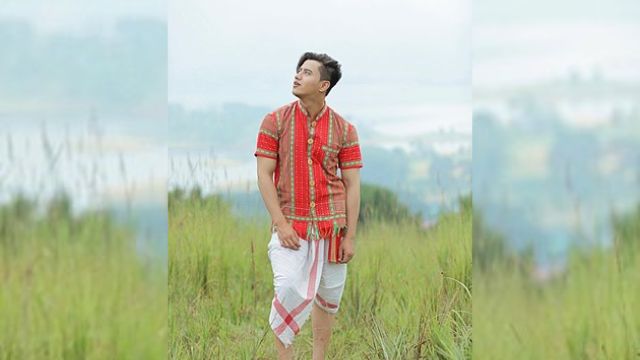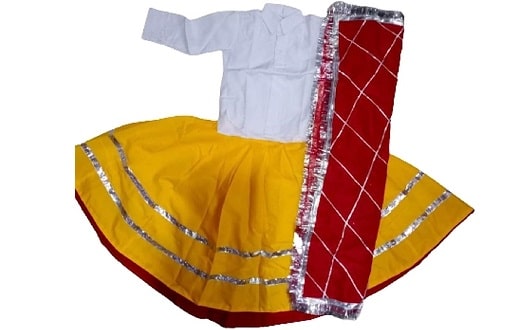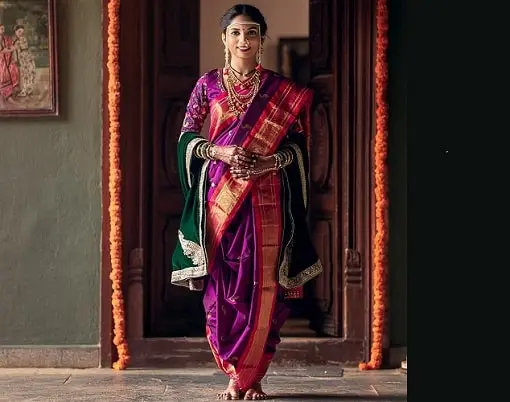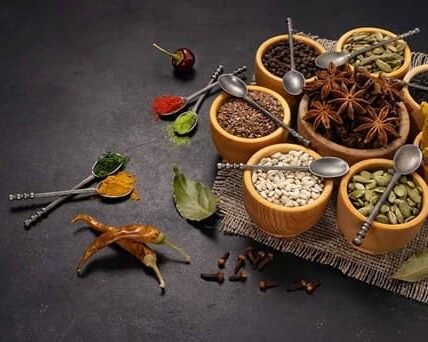Tripura, a state in the northeastern region of India, has a unique history and is rich in culture. The distinctive cultural identity of the area is reflected in Tripura’s traditional clothing, which also displays the indigenous artists’ expert craftsmanship. This post will examine the alluring traditional attire worn by men and women in Tripura while stressing its importance and allure.
Tripura Traditional Dress for Male
In Tripura, men’s traditional clothing combines elegance and simplicity.
The following essential components make up traditional clothing:
Rikutu

A knee-length garment made of silk or cotton is called a Riku. It resembles a dhoti and is put on as the bottom garment. Movement is made possible by the pleated and waist-wrapped Rikutu. Typically, it is plain or adorned with elaborate patterns or borders.
Kamchwlwi
Over the Rikutu, a long-sleeved, buttoned-up shirt is called the Kamchwlwi. Usually, silk or cotton fabric is used to make it. The Kamchwlwi showcases the artistic prowess of Tripura’s craftspeople with stunning embroidery on the cuffs, collar, and front.
Duti Borok
The “Duti Borok” for the loin and the “Kamchwlwi borok” for the upper body make up the traditional attire for men in Tripura. Yet nowadays, only those who live in rural areas and belong to laboring clans still wear this. The man has adapted the contemporary international Gaffa dress style.
Selling
The Seleng is a cotton or silk waist belt frequently woven with elaborate patterns or decorations. It gives a touch of refinement to the entire outfit and is knotted about the waist to fix the Riku. The Seleng is a symbol of Tripura’s artistic and cultural history.
Gacheng
Men in Tripura traditionally adorn their heads with the Gacheng. It often has a bamboo construction and colorful feather decorations that give it a unique look. The Gacheng represents Tripura’s indigenous identity in addition to being a traditional ornament.
Tripura Traditional Dress for Female
Tripura’s traditional women’s clothing is renowned for its vivid colors and elaborate artistry. The following components make up the traditional attire:
Risa
Women in Tripura dress in a magnificent three-piece outfit called the Risa. It consists of a shawl, a shirt, and a wraparound skirt. The skirt is decorated with wonderful handcrafted designs and vivid colours and is made of cotton or silk. The shawl finishes the look, plus the fitted blouse harmonizes with the skirt’s style.
Rinnai
The Risa is made more beautiful by the Rignai, striped belt or a handwoven sash fastened around the waist. It typically features traditional designs and motifs and is created from cotton or silk. The Rignai gives a splash of colour and represents Tripura’s rich cultural history.
Langa
When worn with the Risa, the Langa is a gorgeously embroidered blouse. It has elaborate designs and patterns on the collar, hem, and sleeves that showcase Tripura’s artisans’ amazing handiwork. The Langa enhances the whole outfit’s grace and beauty.
Wedding Dresses
Both men and women dress in intricately embroidered or woven bridal costumes tailored to the unique occasion. The brides purchase expensive clothing, the Rinai, which reaches the knees and crosses the waist. The bride additionally wears a second, more compact garment called a Risa. This vibrant strip of cloth defines the upper half of the garment, which serves to conceal the entire area of the chest ethnically.
Additionally, the upper part of the garment extends below the armpit areas. The beauty and elegance of Risa are defined by its exquisitely floral embroideries, woven patterns, and brocaded embellishments. A coin is the most popular design for wedding jewellery, including earrings, armlets, necklaces, and bangles. These pieces are skilfully crafted from copper, silver, bronze, and other pure metals. Along with delicate and vibrant flowers chosen as decorations, various beads and coins are tied together to create unique neck sets.
Adornments and Jewellery
The women of Tripura accessorize their clothing with various native jewellery, including silver bangles, copper ear and nose rings, and necklaces with coins. Additionally, they dress themselves with flowers to give them a natural grace. Women frequently wear strands of coins and beads around their necks to accentuate their beauty and culture colourfully and seductively.
Women’s clothes get an additional aspect of opulence during festive and joyous occasions. Particularly for dance performances, a sophisticated headdress with a coronal formed from coloured cane and brass embellished with porcupine quills has been added.
To create a visual extravaganza that captures the joy and laughter of these celebratory moments, the tops of these quills are embellished with tufts of contrasting red wool and studded with green feathers from parrot wings.
Conclusion
The men’s and women’s traditional attire of Tripura showcases the state’s abundant cultural heritage and displays the skill of regional artisans. These traditional outfits’ attractiveness and distinctiveness are enhanced by their intriguing patterns, vivid hues, and minutely crafted details. These traditional garments’ preservation and celebration pay homage to the state’s history and guarantee that the traditions and customs are passed down to the next generations, sustaining Tripura’s rich cultural legacy.

Santosh Kumar is an editor at unfoldstuffs.com and a professional content writer. With years of experience he is passionate for creating engaging, informative and impactful topics.









